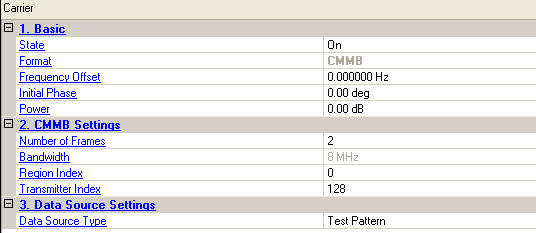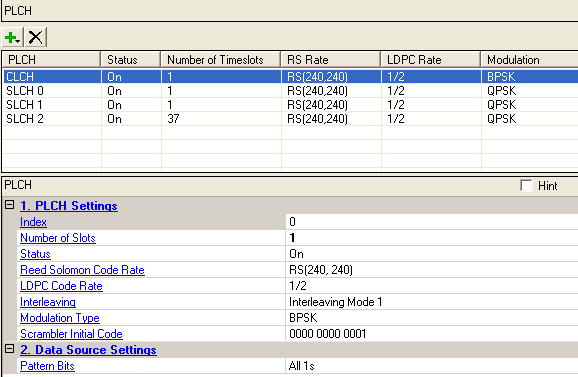
China Multimedia Mobile Broadcasting (CMMB), a mobile television and multimedia standard developed and specified by the State Administration of Radio, Film, and Television (SARFT) in China. It is based on the satellite and terrestrial interactive multiservice infrastructure (STiMi), also developed by China. Announced in October 2006, it has been described as being similar to Europe's DVB-SH standard for digital video broadcast from satellites to handheld devices.

Multi-path Channel (not shown above) is a new parameter under 2. CMMB Settings.
Choice: On |Off
Default: On
Double-click or use the drop-down menu to control the operating state of the carrier.
The format of the carrier.
Range: -40.0 to 40.0 MHz
Default: 0.000000 Hz
Set the frequency offset for the carrier relative to the signal generator’s frequency setting. The valid range will be different for every format due to the different over-sampling ratios.
For example, for 2 carriers configuration, set the center frequency of signal generator to 1 GHz, and make the two carriers distributed on the both sides of the center frequency with 5 MHz offset each. Therefore, the actual frequency of each carrier would be 1GHz+5MHz and 1GHz-5MHz respectively.
Range: 0 to 359 degrees
Set the initial phase of the carrier.
Range: -50 to 0 dB
Set the carrier’s power relative to the signal generator’s amplitude setting.
Set the number of CMMB data frames.
Display the bandwidth of the signal.
Range: 0 to 127
Default: 0
There are 256 sequences in TxID sequence, among which 0~127 is region Index- it’s used for identifying the regions of the transmitter and will be transmitted in the even slots of signal frame (the slot 0, the slot 1, …)
Range: 128 to 255
Default: 128
128~255 is transmitter Identifier- it’s used for identifying different transmitters in the same region and will be transmitted in the odd slots of signal frame (the 1st slot, the slot 3, …).
Default: OFF
Click
in the right side of the cell to open the
![]() Multi-path Channel
configuration window.
Multi-path Channel
configuration window.
A multi-path channel which contains up to 20 paths can be set according to your test requirements.
Choice: Test Pattern | Demo File | Multiplexed File | File by LICH
Default: Test Pattern
Double or use the drop-down menu to select which type to be used as the data source.

Display the PLCH index.
Range: 1 to 40
Default: 40
Set the number of timeslots.
Choice: On |Off
Default: On
Choice: RS(240, 240)|RS(240, 224)|RS(240, 192)|RS(240, 176)
Default: RS(240, 240)
Choice: 1/2|3/4
Default: 1/2
Choice: Interleaving Mode 1|Interleaving Mode 2| Interleaving Mode 3
Default: Interleaving Mode 1
Choice:BPSK|QPSK|16QAM
Default: BPSK
Choice: 0000 0000 0001| 0000 1001 0011| 0000 0100 1100| 0010 1011 0011| 0111 0100 0100|1000 0101 1100| 0001 0110 1101| 1010 1001 0011
Default: 0000 0000 0001
Scramble code is a binary system sequence used for data randomizing. For scramble initial code, it has 8 different available options.
The data bits used as test pattern.
Click
the button on the right side to open the ![]() "Data
Pattern Selection"
dialog and select test pattern to use.
"Data
Pattern Selection"
dialog and select test pattern to use.